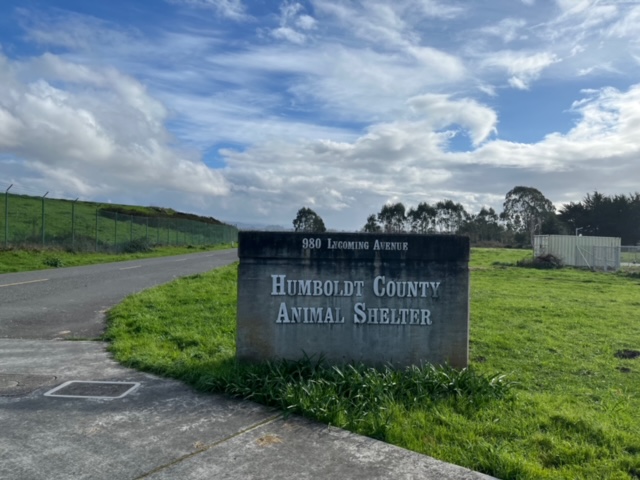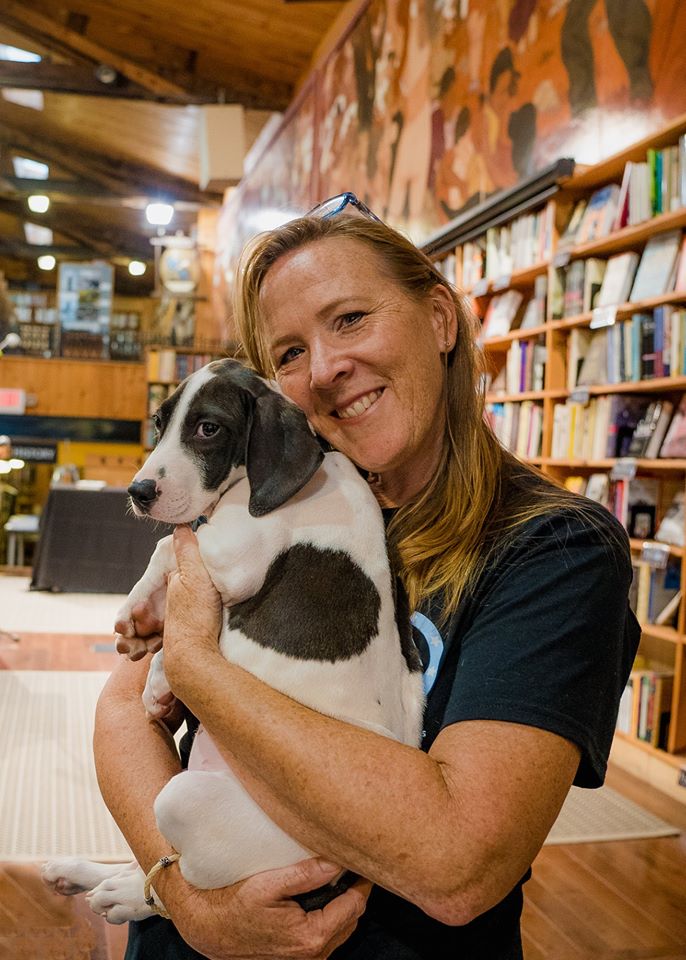My mother-in-law needs a dog. That was the impetus for my visit to Humboldt County Animal Control Shelter in McKinleyville, California. We were visiting, so I suggested we go visit the shelter. I was curious to see if California municipal shelters were struggling with the same issues as the ones we visit in the southeast.

Since this was not a planned shelter visit, I didn’t come prepared with my research, notes, or Nancy to take pictures. My husband, Nick did his best to be Nancy (reaffirming that her job is secure), and I bought a few bags of treats to give out. At the shelter, we met the Shelter manager (and ACO), Andre (pronounced, ‘Ahndra’) who has worked at the shelter for twenty years.
I asked what had changed in that time, and she said that COVID changed everything. The number of animals in need overwhelms. They handle about 1200-1500 animals each year (only animals brought in via Animal Control or the legal system). Owner surrenders are referred to the plethora of rescues in the area. One rescue, in particular, Redwood Pals Rescue, is vital to the shelter. They are a foster-based rescue and all of their members volunteer at the shelter. While we were there, we watched volunteers come and go to walk dogs.



Redwood Pals Rescue is an all-volunteer organization dedicated to support rescue and adoption efforts of animals that are at risk in the Humboldt County Animal Shelter in addition to working to improve the quality of their lives. They pay for training for the dogs in the rescue and at the shelter each week. They also pay to board there are more dogs that need rescuing than they have space in foster homes. They also pay the balance on spay and neutering when the grants run out, pay medical costs of the dogs brought into the rescue, and pay for leashes and treats when the shelter runs low and all the miscellaneous items that give rescue and shelter animals a better life.
Redwood Pals raises money not just to support the shelter and their rescue, but to help the community. The day we were there, one of their volunteers was headed out to a rabies clinic at a local tractor supply. He will stand next to the register and pay for the vet work needed for any of the homeless people who come through.
There is a large population of homeless in the area, many of whom have dogs for companionship and protection. While hiking in the Redwood Forest, we discovered multiple tent encampments and were warned away by resident dogs. It’s quite a different world here. But a beautiful one, and while I’m sure it’s no one’s first choice to live in the woods with their dog, it must be better than struggling in a city.
But back to the shelter. They were incredibly full with dogs (and surprisingly –rabbits! Andre told me they usually get one or two a year, but for some reason currently have eight). Thankfully, kitten season hadn’t begun and their cat area was not full, so they repurposed some of the cat space to house their overflow of dogs.






The shelter was built in 2004 and is pretty nice when I stand it up against the average municipal shelter we visit in the southeast. The dogs have indoor/outdoor kennels with heated floors in the front of the kennels which are spread throughout the complex in a ‘U’ shape. The kennels have solid walls with no dogs facing each other.
There is a four-day stray hold in the county, and after that, the dogs are temperament tested for people, dogs, and food aggression before being made adoptable. They depend on rescues to pull the more vulnerable dogs/puppies, but they do address serious health challenges like treating the occasional heartworm positive dog (not frequently thanks to the lack of hot weather). We met two dogs with special medical needs – both had conditions I’m not familiar with. One will require surgery and the other special dietary challenges, issues that in many other shelters would be the end of their story.
The shelter has a budget of 1.5 million and a staff of eleven. Like everywhere we’ve visited in the south, they are seeing an increase of people wanting to surrender dogs; they easily get ten calls like that a day. There is no open-intake facility in the county, so the best they can do is refer the callers to rescue organizations. And maybe that’s the biggest difference here —there are multiple rescue organizations filling in the gaps. I counted at least eight on their resource list.
I asked Andre, what’s the answer to this overwhelm? She shrugged and said she wished she knew. “Spay and neuter would really help, just to slow the flow of dogs.” There is not a lot of affordable, dog-friendly housing in the area, and there are many, many backyard breeders who set up shop during covid and haven’t slowed down. “They’ll find homes for two or three, and then want to dump the rest with us.”





It is eye opening to me to visit a shelter on the far other end of the country from the shelters we typically visit and discover they are struggling with the same issues. Their dogs were much the same too – lots of shepherd and bully breed mixes, quite a few husky types—so many sweet, but large dogs. The shelter is built to house 58 and when we visited they had closer to 100.


Apparently, it’s a tough time to be an unwanted dog anywhere in the country. Still, I really enjoyed meeting the friendly, knowledgeable, dog-hearted staff and volunteers. And I’m excited to keep tabs on them via my MIL’s involvement at the shelter. She signed up to volunteer at the shelter while she works on convincing her landlord to allow her to have a dog (it’s an ongoing discussion).

If you’d like to learn more visit the Humboldt County Animal Shelter website or visit their Facebook page. You might also want to check out the Redwood Pals Rescue and see the incredible ways they support animals in Humboldt County.
We are packing up for our next shelter tour which leaves this Sunday! We’ll be visiting eleven shelters in SC, AL, MS, AR, KY, and WV. Read more about that tour in last week’s post.
I hope you’ll connect with us on Facebook and Instagram so you can follow along on the tour with us. We’ll be sharing daily reports, Live videos, and plenty of pictures. You can help us raise awareness by liking, commenting, and most importantly sharing our messages. You can also donate to the shelter tour fund to help us buy much needed supplies for all the shelters we visit.

Until each one has a home,
Cara
If you want to learn more, be sure to subscribe to this blog. And help us spread the word by sharing this post with others. Visit our website to learn more.
You can also help raise awareness by following/commenting/sharing us on Facebook, Instagram, YouTube, Tik Tok, and the Who Will Let the Dogs Out podcast.
To see our Emmy-nominated, award-winning short documentary, Amber’s Halfway Home, click here. If you’d like to see it on the big screen (along with other short dog films), check out the tour schedule of The Dog Film Festival, currently in art movie houses all over the country.

Learn more about what is happening in our southern shelters and rescues in the book, One Hundred Dogs & Counting: One Woman, Ten Thousand Miles, and a Journey Into the Heart of Shelters and Rescues (Pegasus Books, 2020). It’s the story of a challenging foster dog who inspired me to travel south to find out where all the dogs were coming from. It tells the story of how Who Will Let the Dogs Out began. Find it anywhere books are sold. A portion of the proceeds of every book sold go to help unwanted animals in the south.
For more information on any of our projects, to talk about rescue in your neck of the woods, or become a WWLDO volunteer, please email whowillletthedogsout@gmail.com or carasueachterberg@gmail.com.
And for links to everything WWLDO check out our Linktree.



Ann Coleman
That does sound like a nice shelter! But I’m sorry it’s so crowded, even without being open admission. The shelter where I volunteer also works with rescue groups, but sadly, the rescues are also usually full. It is nice to see that it has a decent budget, though!
Cara Achterberg
Yeah, I was really hoping there would be a better story there. Kind of speaks to this moment in time in shelters all over the country with resources and without.